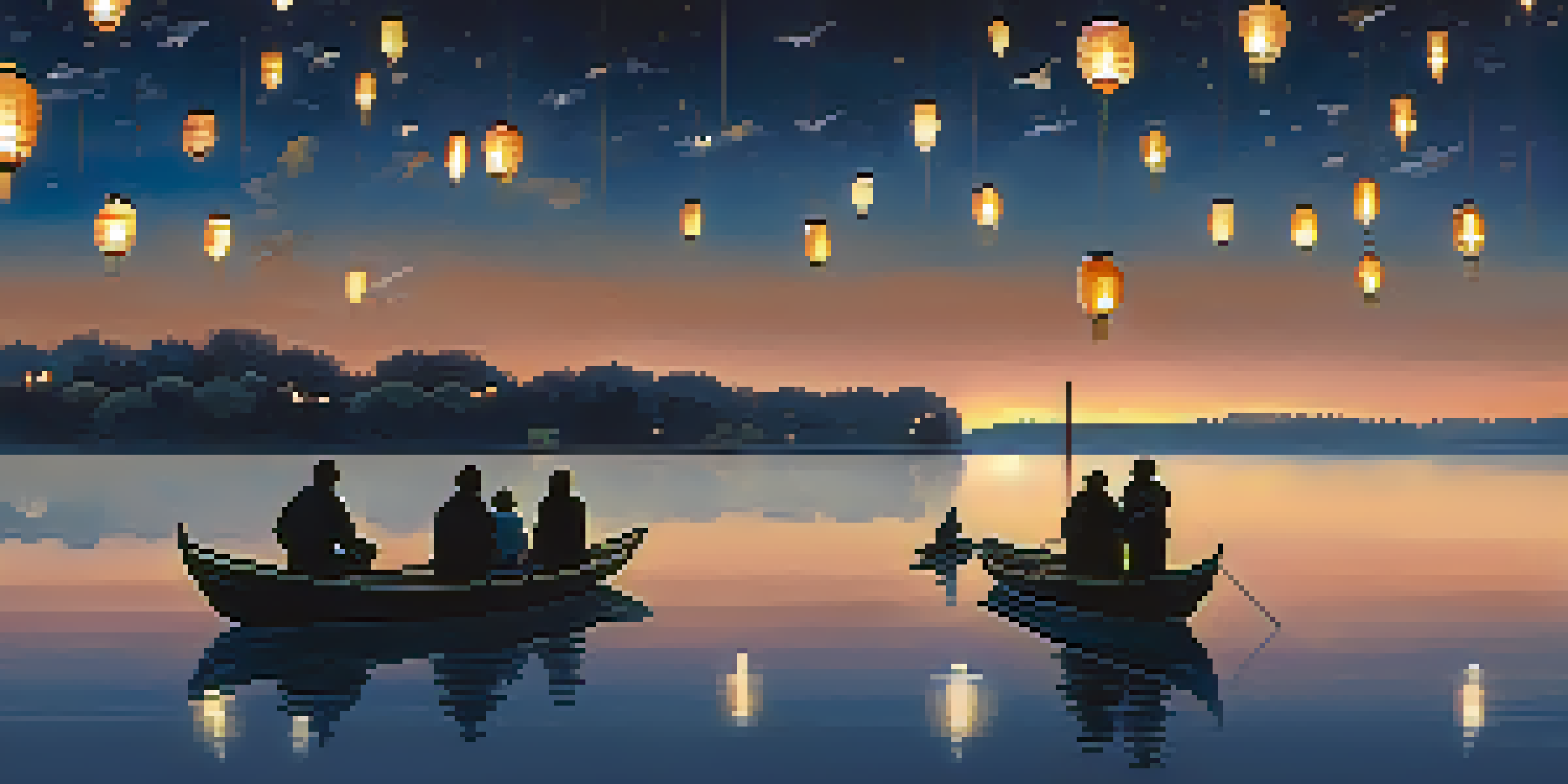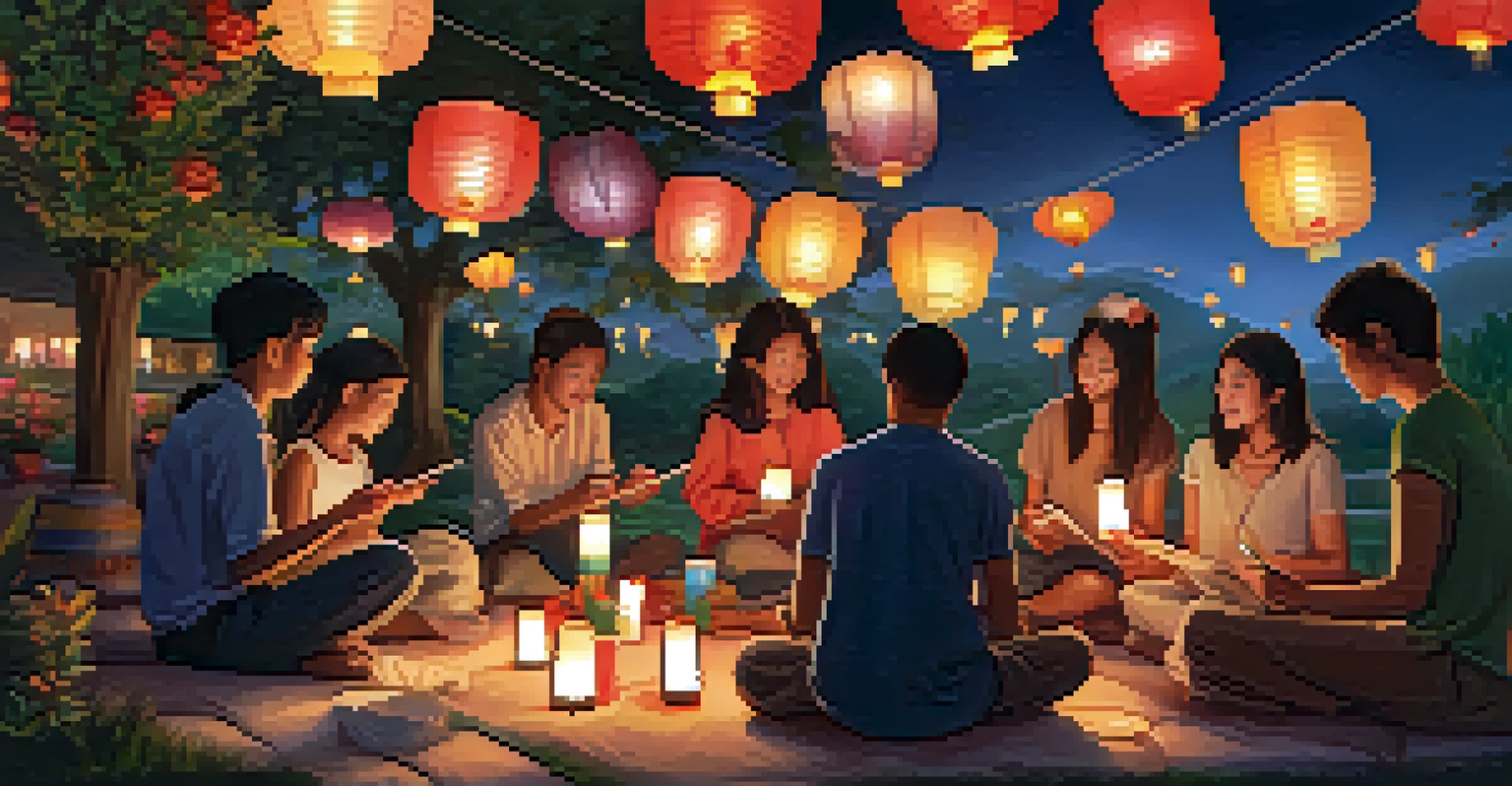Lantern Floating Ceremony: Honoring Lives and Memories

Understanding the Lantern Floating Ceremony's Origins
The Lantern Floating Ceremony has roots in various cultures, most notably in Asia. It is a beautiful practice that symbolizes the release of one's sorrows and the honoring of loved ones who have passed away. Often celebrated during significant dates, such as the Obon festival in Japan, this ceremony brings together families and communities in remembrance and reflection.
What we have once enjoyed we can never lose. All that we love deeply becomes a part of us.
Participants prepare lanterns, often inscribed with messages or names, to float on water. This act not only signifies sending off the spirits of the departed but also serves as a way for the living to express their grief and love. The gentle glow of the lanterns against the night sky creates a tranquil atmosphere, inviting a sense of peace and connection.
As you witness the lanterns drift away, it becomes a poignant reminder of the transience of life and the enduring bond between those who have left us and those who remain. This ceremony encapsulates a universal theme—the celebration of life and the memories we cherish.
How the Ceremony is Celebrated Around the World
While the Lantern Floating Ceremony is most commonly associated with Asian cultures, variations exist globally. In Hawaii, for example, the Lantern Floating Hawaii event draws thousands each year, where participants honor their loved ones by releasing lanterns into the ocean. This celebration not only holds cultural significance but also fosters community spirit and collective healing.

In other regions, similar practices may involve lighting candles or releasing floating lanterns onto rivers, lakes, or even into the sky. Each tradition, while unique, shares a common thread of remembrance and honoring those who have passed. The essence of these ceremonies lies in their ability to unite communities and foster a sense of belonging.
Cultural Roots of Lantern Ceremonies
The Lantern Floating Ceremony has deep cultural significance, symbolizing remembrance and connection across various traditions.
These global adaptations of the Lantern Floating Ceremony highlight the profound human need to connect with our past, grieve collectively, and celebrate life. Regardless of location, the act of floating lanterns creates a moment of reflection and peace for all involved.
The Symbolism Behind the Lanterns
Lanterns are much more than just beautiful objects; they carry deep symbolism. Traditionally, they represent light in the darkness, guiding spirits home and illuminating the path for the living. Each lantern acts as a vessel for memories, hopes, and messages, creating a tangible connection between the physical and spiritual realms.
The journey of grief is a journey of love.
The act of writing on the lanterns—be it names, quotes, or personal messages—adds a layer of intimacy to the ceremony. It transforms a simple object into a heartfelt tribute, allowing participants to express their love and longing. As these lanterns float away, they embody the release of grief and the celebration of cherished moments shared with the departed.
Moreover, the gentle flickering of the lanterns symbolizes hope, reminding participants that even in darkness, there is always light. This profound symbolism fosters a sense of closure and peace, helping individuals navigate their grief while honoring the lives of those they have lost.
Creating Your Own Lantern Floating Ceremony
If you're inspired by the Lantern Floating Ceremony, consider creating your own intimate gathering. Start by selecting a serene location—perhaps a lake, river, or even your backyard. Gather family and friends, and encourage everyone to bring their own lanterns, reflecting their personal memories and sentiments.
Before launching the lanterns, create a moment of togetherness. Share stories about your loved ones, reflect on cherished memories, and perhaps even play music that resonates with the occasion. This collective sharing can transform the ceremony into a powerful healing experience, strengthening bonds among participants.
Emotional Healing Through Remembrance
Participating in the ceremony provides a safe space for emotional release and fosters a sense of community among those grieving.
When the moment arrives to release the lanterns, take a deep breath and allow the emotions to flow. As you watch the lanterns drift away, remember that this act is not just about saying goodbye; it's about celebrating the love and lives that remain in your heart.
The Emotional Impact of the Ceremony
The Lantern Floating Ceremony can evoke a wide range of emotions, from sorrow to peace. It provides a safe space for individuals to confront their grief, allowing them to express feelings that may have been bottled up for too long. This emotional release is essential for healing, as it acknowledges the pain while also celebrating the joy of memories.
Participants often report feeling a sense of closure after the ceremony, as if their loved ones are somehow present during the experience. The act of floating lanterns serves as a powerful metaphor for letting go, reminding us that it's okay to move forward while still holding onto the love we shared.
Additionally, the communal aspect of the ceremony fosters connection and support. Knowing that others are experiencing similar emotions can create a sense of belonging, alleviating feelings of isolation that often accompany grief. In this shared space, healing becomes a collective journey.
Incorporating Cultural Practices into the Ceremony
To deepen the experience of a Lantern Floating Ceremony, consider incorporating cultural practices that resonate with participants. For instance, some may choose to include traditional prayers, songs, or even food that honors the lives being remembered. These elements can enrich the ceremony, making it more meaningful and personal.
Exploring the cultural significance of the lanterns can also provide a greater understanding of their symbolism. For example, in some Asian traditions, colors may hold specific meanings, representing different aspects of life and death. By embracing these cultural nuances, participants can create a richer, more respectful experience.
Creating Personal Lantern Experiences
Individuals can craft their own meaningful ceremonies by incorporating personal stories and cultural practices to honor loved ones.
Moreover, inviting individuals from diverse backgrounds can encourage a beautiful exchange of traditions and stories. This melding of cultures not only honors the departed but also fosters a deeper appreciation for the varied ways we all remember and celebrate life.
The Lasting Legacy of the Lantern Floating Ceremony
The legacy of the Lantern Floating Ceremony extends far beyond the event itself; it leaves a lasting impact on those who participate. It serves as a reminder that remembrance is a continuous journey, woven into the fabric of our lives. The memories we honor during the ceremony become a part of our personal stories, shaping how we navigate our grief.
As communities gather to witness the floating lanterns, they create a collective memory that reinforces the importance of connection and remembrance. These gatherings can spark conversations about life, loss, and love, encouraging individuals to share their stories and support one another in their healing journeys.

Ultimately, the Lantern Floating Ceremony teaches us that while we may experience loss, the love we hold for those who have passed remains ever-present. Each lantern that floats away becomes a symbol of that enduring love, illuminating the way for others who may still be navigating their own paths of remembrance.